THIS ARTICLE IS WRITTEN BY MILES HARRISON– LINK TO ORIGINAL ARTICLE — > https://light.fish/blog/torch-coral
Whether you’re new to reef keeping or an avid coral collector, you’ve probably seen or heard about torch corals. Coral exports from Australia have increased steadily since 2007, and as a result, we’ve seen a wide variety of colorful torch corals introduced to the reef-keeping hobby.
While torch corals were once some of the most affordable, the popularity of new variations has made them some of the most expensive corals around. They’ve become so popular that Reef Builders named 2022 the year of the torch coral .
Torch corals are easy to keep, and the colors they produce are nothing short of mesmerizing. If you’re interested in adding a torch coral to your saltwater aquarium, it’s your responsibility to be well-versed in their care. In this guide, we’re going to cover everything you’ll need to know before owning this species. We’ll discuss some of our favorite torches, and we’ll recommend best practices when it comes to feeding, fragging, lighting, and much more.
The torch coral (scientific name: Euphyllia glabrescens) can be found throughout the world’s oceans, living in reefs down to 115 feet below the surface. While variations of this species can be found in places such as the Red Sea and the Gulf of Aden, most of the torch corals we see in the aquarium hobby come from two places – Indonesia and Fiji. Over 30,000 torch corals are exported from these countries annually.
Torch corals have earned a few different nicknames over the years, and are occasionally referred to as Branch Corals and Pom Pom Corals. It’s easy to understand how they’ve earned these names. Torch corals have long, flowing tentacles, with brightly colored tips, resembling the lit portion of a torch or a pom-pom.
The tips of a torch coral’s tentacles serve an important purpose. These tips, known as cnidocytes (pronounced: ny-doe-sites) are specialized cells that contain a secretory organelle containing a toxin. This organelle gives the torch coral offensive and defensive capabilities; it can sting and capture prey, or ward off any encroaching predators. It’s this exact feature that defines the entire phylum of corals, anemones, and jellyfish!
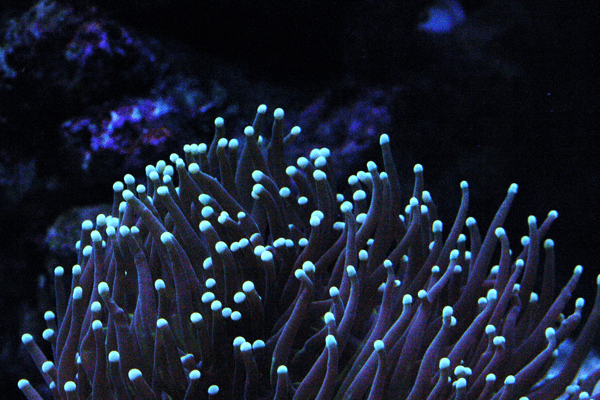
Torch corals are measured horizontally, and will grow to reach about 10 inches in an aquarium. The length of tentacles tends to average 6 inches in length.
In the wild, they can grow to be a bit bigger, with some torch corals growing to be about 20 inches long.
From the Author: Keep in mind that the tentacles will flow around the aquarium, while the foot of the coral may only be 10 inches, when you add the flowing tentacles, you’ll want to account for an additional 10 inches of space if you’re planning an aquarium layout.
Torch corals are slow growers, and will produce 1-2 heads every 3-7 months.
Feeding your corals a well-balanced diet, and providing them with the best environment possible will ensure your corals are healthy and capable of growing without any issues. Unlike anemones, torch corals are not capable of splitting.
Torch corals are members of the Euphyllia family. Members of this family include the similar-looking frogspawn coral and hammer coral. It’s easy to mistake a torch coral for one of these related species but they do have visual differences. The tips of hammer corals resemble, as you may have guessed, a hammer. While frogspawn corals are known for their multi-branching tentacles.
There are a wide variety of interesting torch corals, and some variations have earned some incredibly high price tags.
Indonesian torches, often abbreviated as “Indo torches” are much more common than their Australian counterparts.
Indonesian torches have long thin tentacles, with small tips. Some of the most well-known torches, such as the NY Knicks and Neon Green Tip Torch are Indonesian, as well as a plethora of many others. Here are some of our favorites.
One of the most commonly available torches, the neon green tip torch is well-priced, making it an excellent choice for beginners looking to acquire their first torch. The tentacles have a light-brown color, but the tips of this coral are vibrant neon green.
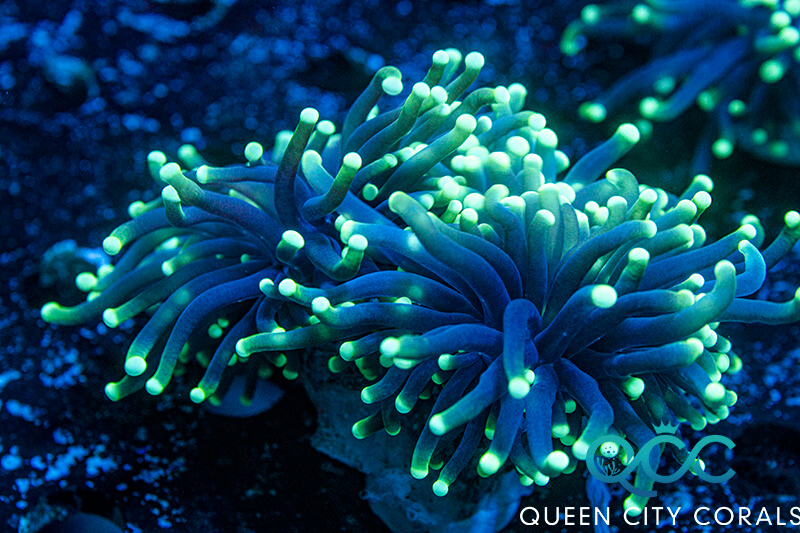
You don’t have to be a New York Knicks fan to appreciate this colorful torch. This coral’s colors match that of the famous NBA team, the New York Knicks. A green mouth with gold tentacles and blue tips are the defining features of the New York Knicks Gold Torch.
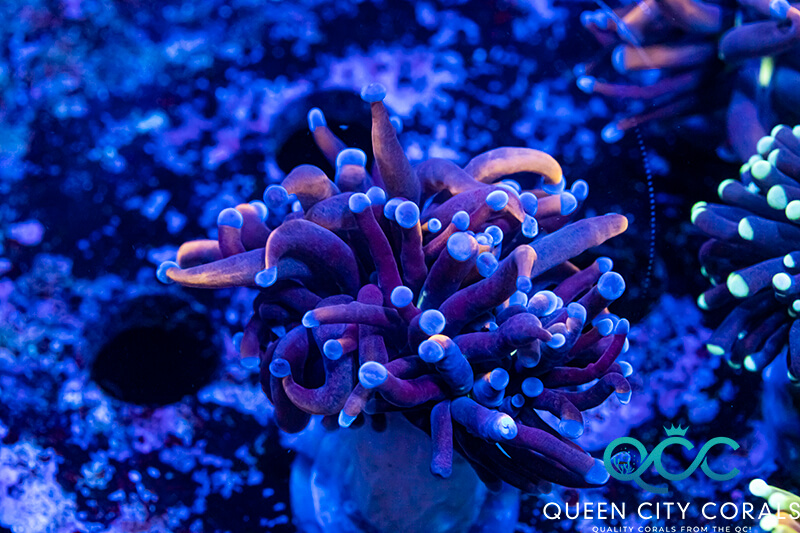
Purple tentacles that transition to neon-green tips are what you’ll want to look for in an Indo Hellfire Torch.
It’s an uncommon torch, with a price to match. Hobbyists can expect to pay around $170 for a single polyp of this species.
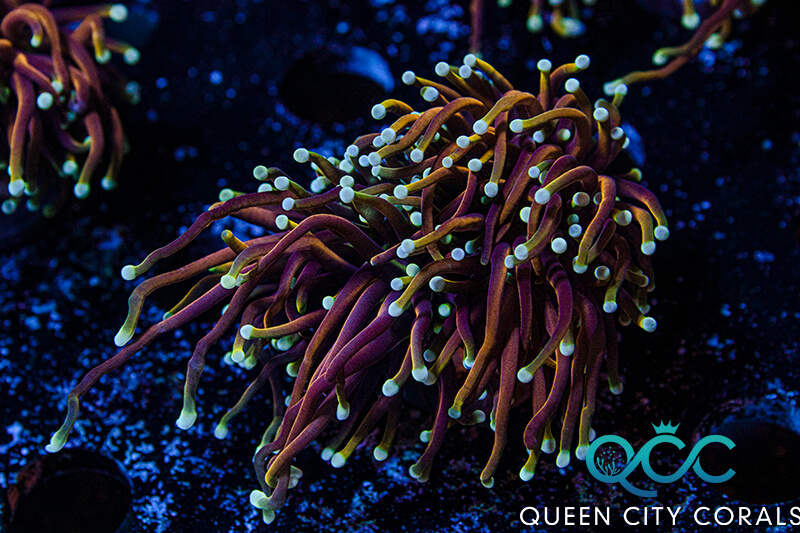
One of the most sought-after torches, the dragon soul torch is known for its bright colors. This torch has light purple tentacles that transition to cyan-colored tips.
You’ll pay a premium price for this unique coral, and single polyps can go for $250.
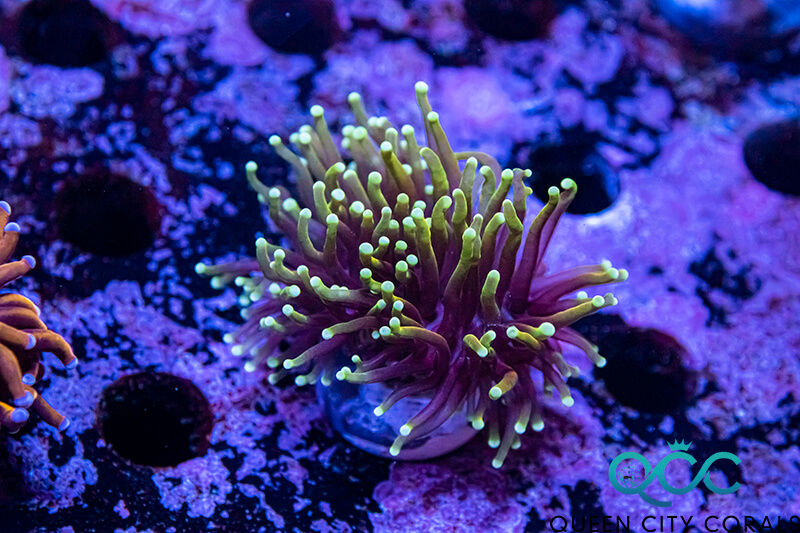
Known for its neon green tentacles and multi-colored tips, the cotton candy torch is a vibrant variation of the Euphyllia glabrescens species. While many retailers use the name “Cotton Candy” to define different torches, neon green tentacles with multi-colored, blue, or pink tips are the common features of torches referred to as cotton candy.
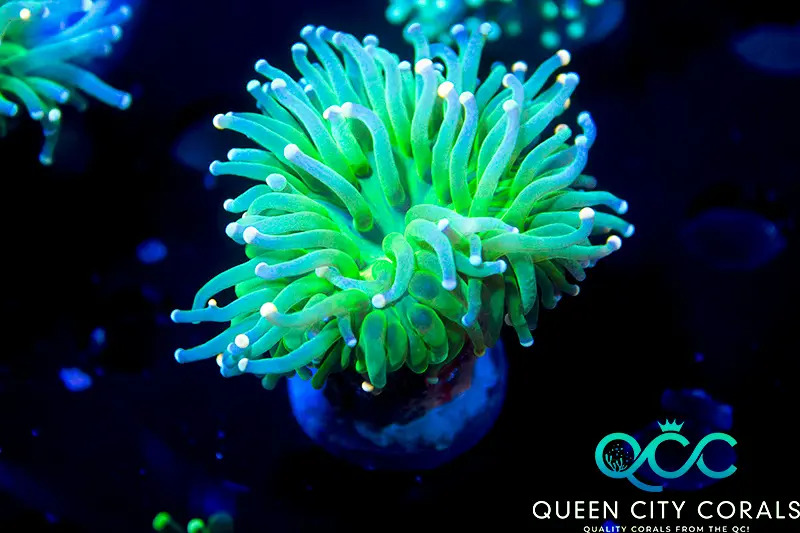
Australian torches can be found throughout the great barrier reef and the islands of Fiji, and have smaller, thicker tentacles and thicker heads.
They’re less common than Indonesian torches, but offer some of the brightest yellows and golds in the Euphyllia glabrescens species.
While some aquarists may refer to other torches as a holy grail torch, the consensus is that the holy grail torch is a Euphyllia glabrescens that has yellow tentacles with light blue tips. There should be no green coloration in the tentacle, only the mouth of the coral should have neon green coloration.
It’s incredibly rare to find a coral with this clear separation of colors, so it’s common to see corals with a bit of green still labeled as a holy grail torch. Torches with these colors are some of the most expensive and can go for over $1000.
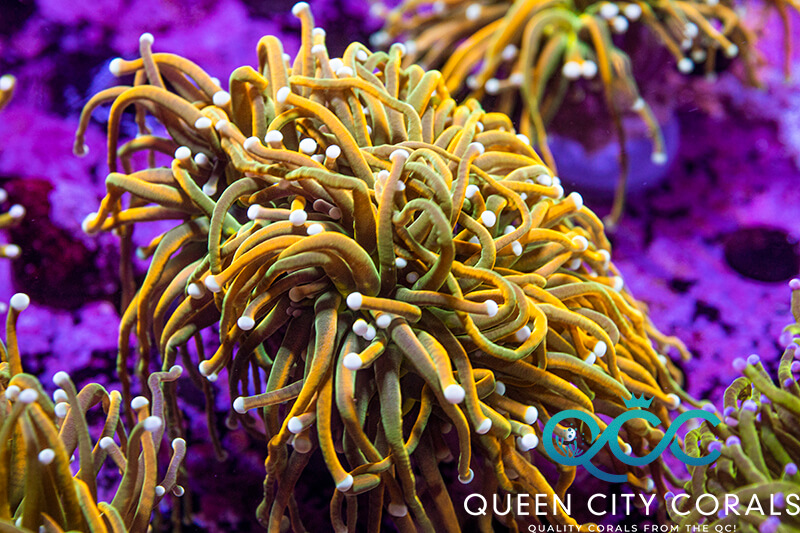
Yellow tentacles that transition to neon green with cyan-colored tips are the defining features of a reverse tiger torch. Similar to the holy grail, you’ll pay a premium for the yellow tentacles, as these torches can cost up to $600.
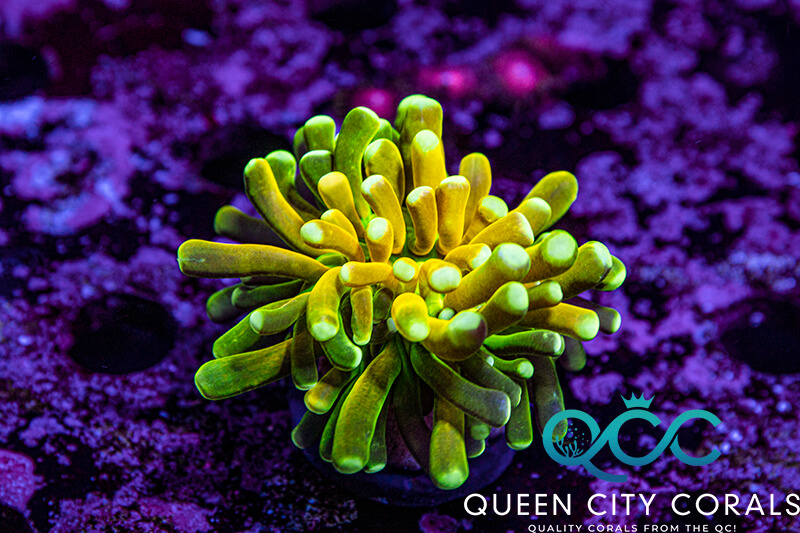
Cristata torches are not the same species as Euphyllia glabrescens, their scientific name is Euphyllia cristata, and although they aren’t as common, they are much more affordable.
Cristata torches have knob-like tips, and while some may find this undesirable, we love the look of the larger tips. Unfortunately, they’re slow growers and will stay quite small, but if you’re looking to save a few bucks, the cristata torch may be the perfect option.
Deep purple tentacles make this affordable coral one of our favorites. Its teal tips are eye-catching, and although it’s a slow grower, it’s the perfect choice for a budget coral, as it’s priced at only $50.
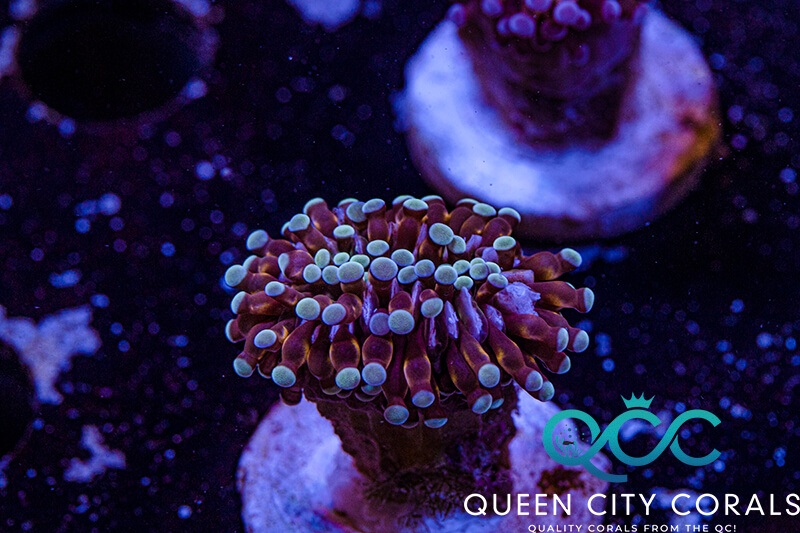
One of the biggest attractions to owning a torch coral is its ease of care. They’re a great entry coral to the reef-keeping hobby and are often recommended to beginners.
However, just because they’re beginner friendly, doesn’t mean you can ignore their care requirements. Torch corals are large polyp stony corals, and you’ll need to provide certain conditions for these corals to survive and grow in a reef aquarium.
Torch corals will attack other nearby corals, including other species of Euphyllia glabrescens, so we recommend having an aquarium that’s at least 30 gallons in size.
Having an aquarium this size will give you plenty of space to prevent any potential territory disputes. If you’ve already placed your corals near one another, you’ll want to relocate any torches so that they’ll have plenty of space.
From the Author: It’s a common misconception that torches won’t attack each other. While most of the time torch corals can co-exist quite peacefully, it’s not a guarantee, so you’ll want to keep them spread out.
You’ll want to re-create the torch coral’s natural environment as closely as possible. In the wild, these corals live in reefs throughout the islands of Fiji and the shallow lagoons of Indonesia.
Aim for the following if you plan on keeping a torch coral:
Specific Gravity: 1.023-1.025
Temperature Range: 72°F-78°F
KH: 8-12 dKH
Calcium: 400 ppm
Magnesium: 1250-1350 ppm
pH: 8.1-8.4
LPS corals are more tolerant than most corals when it comes to changes in water chemistry. Keep Nitrate levels between 5-10 ppm, and phosphate levels no higher than 0.03 ppm. If your phosphate levels are higher, you’ll want to lower your phosphate levels.
If you’re planning a new reef tank, one of the best things you can do is plan out your aquascape ahead of time. Knowing what equipment you’ll need, and where you’re going to position your corals and live rock can give you more flexibility if you plan on making adjustments in the future.
While it can be difficult to balance all of the inhabitants of a reef aquarium, if you plan on adding torch corals, you’ll need to understand where the torch should be positioned, its lighting requirements, and the amount of flow needed for it to thrive.
Torch Corals should be placed at the bottom, or near the middle of the aquarium.
You’ll want to make sure that your torch coral is far away from any neighboring corals. Any coral within reach of a torch can become a victim to a torch coral’s sweeper tentacles. Keep this in mind if you’re adding multiple corals to your reef tank.
You’ll want to have low-medium light if you plan on keeping torch corals. If you own a par meter , readings of 30-150 PAR are ideal for torch corals.
If you notice your torch turning white or shrinking, your lights are either too intense, or the lighting duration is far too long.
From the Author: Some of our favorite bulbs for showcasing the colors in torches are the ATI True Actinic
.
Torch Corals should be placed in the tank where they will receive low to moderate flow. They should gently sway in the water column, but shouldn’t appear as if they’re being blown around.
You can reduce the amount of flow your torch coral is experiencing by positioning it behind live rock or by moving it out of the direction of a powerhead. Adjustable powerheads, such as those from ecotech marine have programmable flow levels, making adjustments a breeze.
Torch Corals should be spot fed at least once a week with Reef Roids or Mysis shrimp.
You can fill a pipette and release a small amount of food directly above each coral. Spot feeding can even help in the recovery of damaged corals, and will encourage healthy growth.
Remember not to overfeed. Overfeeding will create more waste, resulting in water chemistry changes. If you have sensitive fish, such as a wrasse, you’ll always want to ensure that you’re not overfeeding.
If you have a reef aquarium without fish or other invertebrates, you can increase feedings to 2-3 times a week.
Torch Corals have aggressive personalities, and will attack any coral that crosses their path using their sweeper tentacles. These sweeper tentacles can grow quite large and can reach up to 12 inches in length. The tentacles will appear when the coral senses another coral close by.
From the Author: Torch Corals will even sting their owners! Although rare, if stung, the sting can be incredibly painful. You should seek medical attention as soon as possible if you’ve been stung by a Torch Coral. Although rare, it’s possible to experience an allergic reaction to a torch coral sting.
Whether you’re looking to grow corals to ship to other hobbyists or bring to your next trade show, fragging torches is a great way to make some extra cash and meet other members of the reef-keeping community.
If you own a band saw , the steps to frag these corals are relatively straightforward.
You’ll first want to have the tentacles retracted to make cutting a bit easier. Then, using a bandsaw and eye protection, cut through the coral’s branch. Dry the bottoms, glue them to a frag plug or magnetic mount and let it set for a minute or two.
After a few minutes have passed, you can add the coral back into your aquarium, or place it on a frag rack.
With their long, flowing tentacles, torch corals look excellent in an aquarium with other types of coral or fish.
Pretty much any reef compatible fish will go well with torch corals, but here are some of our favorites:
Avoid any clownfish species, such as maroon clownfish, saddleback clownfish, pink skunk clownfish or snowflake clownfish. In some rare cases, they can peacefully coexist, but most clownfish will kill torch corals, and you’ll need to either remove the corals or the fish to remedy the problem.
Other genera of coral, such as Micromussa and Acanthera can add some diversity to the aquarium, just be sure to give them enough space so that they don’t risk getting stung by a coral torch’s sweeper tentacles.
As you can see, it’s no surprise that torch corals have dramatically increased in popularity within the past few years. The colors they’re capable of producing are almost otherworldly, but you could make the argument that coral reefs are truly a world of their own.
Now that you know everything there is to know about torch corals, do you see yourself adding one of these to your reef tank in the future?
We do our best to cover topics as accurately as possible. If you have any feedback or suggestions, be sure to let us know by commenting below, and check out our marketplace and community forum where hobbyists sell coral and discuss everything related to reef keeping.
Huge shoutout to North Carolina-based Queen City Corals for letting us use some of their photos, be sure to check them out for some of the best corals in the hobby!